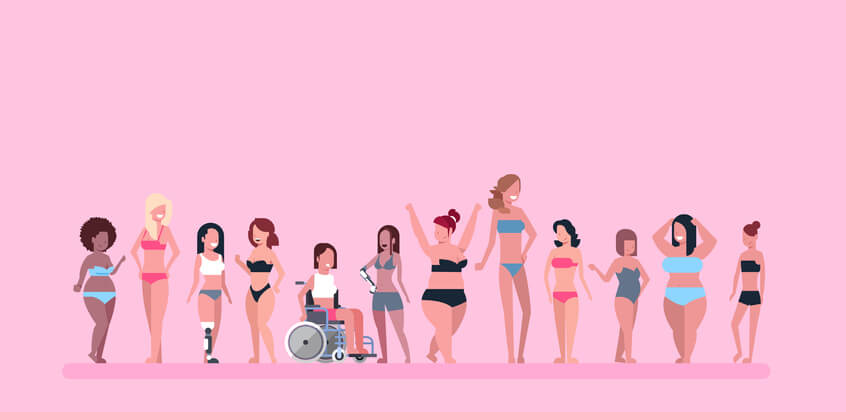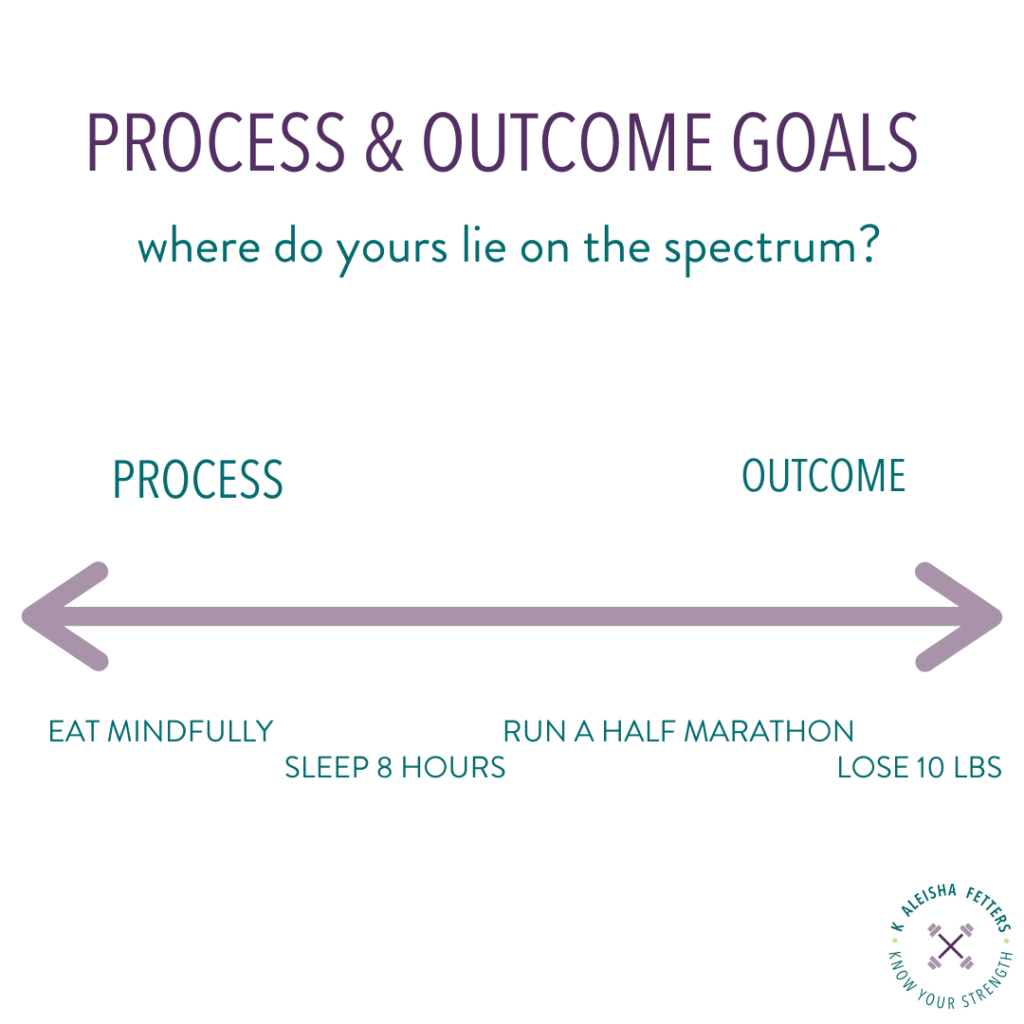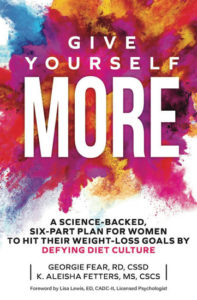
Truly loving your body radically alters your attitude with which you seek any physical goal. It allows you to work toward those women’s body goals with an eagerness to connect with, grow, care for, and fall more in love with your body, rather than to correct, fix, or punish it.
Women, Body Goals, and ID-ing the Right Ones for You
If establishing love-based goals is pivotal to giving yourself MORE, what are your different body goals? What about your body do you want to change? What about it do we want to stay the same? What qualities or abilities do you love and want to build on?
Here, you’ll learn how to establish motivating, empowering body goals for women that nurture your physical, mental, and emotional health.
Step 1: Determine What Women’s Body Goals and Women’s Fitness Goals Really Matter to You
Unfortunately, a lot of women’s body goals are actually someone else’s—internalized over decades of conditioning. So it can be incredibly powerful to straight-up ask yourself, “Is this something I want?”
Still, it’s not easy to tease apart what we truly want from what we believe we are supposed to want, but it is possible with introspection and practice.
Go ahead and write down all of your current body goals and women’s fitness goals. No censoring; as soon as something pops into your head, write it down!
Now, pick one of those goals and consider the following questions. As you move through the prompts, plug your answers into the chart below. It doesn’t matter which you select first, we’re going to repeat this exercise for all of them! (The chart has room for five goals, but don’t feel like you have to limit yourself. If you run over, keep going.)
| GOAL | |
| When Do I Remember First Having this Goal? | |
| How Will I Feel When I Achieve this Goal? | |
| How Will Striving Toward this Goal Affect My Life—And How Does that Make Me Feel? | |
| Is this Goal—And the Work Involved in Reaching It—in Line with My Values? | |
| Who in My Life Has Suggested this Goal? And Why? | |
| At Any Point, Have I Said “Should”? |
When Do I Remember First Having This Goal?
Maybe it’s when a kid at school made fun of your weight or you first noticed your mom’s dieting. Maybe you don’t remember the first time the body or fitness goal occurred to you, but you can’t remember ever not having it.
Whatever the case, seeing how this goal falls on a timeline can be helpful in determining its roots.
How Will I Feel When I Achieve This Goal?
Achieving goals can make us feel capable, strong, talented, and tenacious—and that’s great. However, many of us enter into goals believing that their achievement will make us feel worthy, happier in all areas of our lives, or loved.
None of these things are contingent upon performance! You are a worthy human, irrespective of your performance. Losing 10 pounds will not make you a happier person. A “2” printed on the tag inside your jeans won’t make you happy in your job. Having a six-pack will not earn you love or allow you to better receive it.
How Will Striving Toward This Goal Affect My Life—And How Does That Make Me Feel?
Just because you think it would be awesome to run a marathon doesn’t mean you want to run up to 40 or 50 miles per week in order to enter the race strong and finish injury-free. In some cases, the simple realization that you want the result, but not what’s involved in reaching it, is reason enough to abandon or revise your goals.
However, just because you don’t want to do something doesn’t necessarily mean it isn’t worth it—and that’s a call that only you can make.
So if you really, really, really, want to run that marathon and have it as a bucket-list fitness goal, but don’t exactly want to spend so much time training, consider how that training will affect your life.
You’ll obviously spend a good bit of time running, and it’s likely that you’ll improve your blood pressure, aerobic capacity, and muscle strength and endurance in the process. If you don’t properly train, and even if you do, it’s possible that you’ll experience some sort of training ache, pain, or injury. You will also likely have to rework your daily habits to make time for your training. Maybe you’ll have to exercise on your lunch breaks or devote Saturdays to long runs. You might need your partner to prepare dinner or put the kids to bed without you some nights.
That’s a lot of possibilities—some positive, others not so much. For some goals, you might not know how working toward them will affect your life. You might think you do, when in fact the work required is actually significantly more or less.
Women often approach Aleisha and Georgie with different fitness and body goals that, once exploring, they realize are either unrealistic or unhealthy. A client might want to lose 20 pounds in two months. However, that’s a rate of weight loss that puts her at a great risk for rebounding, and also isn’t the best for her overall health. For example, losing weight so quickly might result in her losing as much weight from muscle as from fat.
RELATED: Is This the Reason You Can’t Lose Those Last 5 Pounds?
Another client might want to get to to a body fat percentage of 12 percent, but be unaware that, at this level, some women can lose their periods—and not in a “yay, no more periods!” way. Instead, hormone levels can fluctuate to a degree that women’s reproductive organs’ regular functions cease. These hormonal changes can also lead to decreased bone mineral density and, even in some young women, osteoporosis and frequent bone breaks.
On the flip side, many clients also approach us with body and fitness goals that they think will involve more work or be far harder than they actually will. They might think they need to deprive themselves of the foods they love and hit the gym seven days a week. Some, like we discussed before, think that they have to push themselves to pain.
In the end, determining exactly what work will be involved in reaching any given goal isn’t always easy. They didn’t really teach this stuff in health class, and it can feel like everything that you find online is conflicting.
For that reason, it’s important to educate yourself on your specific goal by turning to reputable sources (-.edu, -.gov, and -.org sites are a good place to start, as is this site; wink) and working with qualified health professionals. Letters to look for: MD, DO, PhD, RD, CSSD, CSCS, (D)PT, CPT. Of course, letters aren’t the only making of a knowledgeable source, but they’re a good place to start.
Is This Goal—And the Work Involved in Reaching it—in Line with My Values?
If you value being in nature, hiking, exploring, and camping, a women’s fitness goal to build the strength and endurance to climb hills, scramble over rocks, and carry firewood would be very much aligned with your values. However, if you value social time with friends and family, vowing to never eat out should be a hard pass.
RELATED: This Is What Healthy Weight Loss Looks Like
Pursuing women’s body goals that are aligned with your values orients your motivation as internal, increasing their intrinsic nature. That explains, for instance, why it’s often easier to make large behavior changes for ethical, religious-, or value-based reasons.
For example, when cutting down on or removing animal products from meals, ethical or identity-based reasons are often far more motivating over the long term compared to health-related ones. The same goes for eating kosher or halal or biking to work.
Who in My Life Has Suggested this Women’s Body Goal? And Why?
It’s possible for people, even loved ones, to push different body goals as a result of their own body-image issues, insecurities, or weight stigmas.
A mother might suggest that her daughter lose weight because she believes her friends will think less of the daughter, and therefore also her, if her daughter is overweight. What’s more, negative comments (e.g. “you really need to watch what you eat”) often serve as a way to make the commenter feel better about their own body. Again, since people tend to think in terms of relatives and social comparisons, deriding someone else’s perceived flaws can be a way to temporarily boost their sense of self-worth.
However, just because someone else has mentioned or suggested a goal to you doesn’t necessarily mean it can’t be your goal, too. In fact, those who love and support us often suggest pursuing goals designed to give ourselves MORE.
For example, a family member may express that they want you to to exercise more because you are more energetic and mentally healthy when you’re regularly engaging in exercise. Maybe they want you to be around for a long time, and consider weight loss or changing your eating habits as a way to increase the quality and length of your life.
Trusted friends and family members with whom we have deep, meaningful relationships can be important sounding boards in our lives. These people often have insights into our nature and habits that we aren’t even aware of in ourselves. Take advantage of their presence to help you process your women’s body goals, unpack the motivations behind them, and think through how they might impact various aspects of your life.
At Any Point, Have I Said “Should”?
Saying “should” is a pretty strong sign that you feel something is being forced upon you. It may be that the goal—or what we think must be done to reach it—is something we have internalized
At the very least, it’s likely that we don’t feel good about whatever it is that we “should” do, and that, over the long term, our chances of sticking with it are minimal. It suggests that it’s extrinsic, rather than intrinsic, motivation that’s behind our goal. And as we mentioned before, extrinsic motivation wears out fast.
| Got Aesthetic Goals?
These are tricky! Caring about your visual appearance is completely normal and OK. At the same time, however, if we think about looks as the only criterion for what a “good body” is, we impede our ability to appreciate every other aspect of our body. Focusing on outward appearance detracts from the attention we can pay to appreciating how physically capable our bodies are (“hey, I moved those boxes all by myself!”) or the resilience they show, repairing themselves after injury and recovering from illness and infection. If any aesthetic women’s body goals pop up for you, make sure to run them through this list of mental checks and balances so that you can approach them in the healthiest way possible. |
Step 2: Turn Loss Into Gain
After determining what women’s body goals truly matter to us, it can be good to also think through how we can reframe those goals to make them even more internal or compatible with what’s important to us. How can we reframe them to make them feel better to us; like they are helping us give ourselves more—more vitality, freedom, body love, pleasure, more of everything we value?
RELATED: Food Is Not a Reward and Exercise Is Not a Punishment
One simple way is to look at every goal that seeks LESS and examine how it would feel to rework it into a goal for MORE.
Write down all of your different body goals and women’s fitness goals that concern loss or subtracting from your body. Then, try to reword the goal in a way that focuses on the positive, and what you have to gain, rather than lose. Lastly, write down how this mental reframe feels. Does it feel more motivating? Does letting go of your loss-focused goals make you uneasy? There are no right or wrong answers here. Just exploration.
If you’re feeling stuck (don’t worry, this can be pretty counterintuitive for women at first!) take a look at this filled-in example. Your answers don’t have to look anything like these, and it’s possible that you’ll have more or fewer loss-centric body goals to work through.
| GOAL FOR LESS | REFRAMED FOR MORE | HOW DOES THIS FEEL? |
| Lose 20 pounds. | Have more energy. | This feels aggressive! |
| Burn at least 500 calories in every workout. | Move an hour during each workout. | Sounds like it will require a lot less tracking. |
| Get rid of my belly pooch. | Define my core. | Excited! |
| Cut calories. | Eat more fruits and veggies. | Good. I hate counting calories. |
| Make my arms less jiggly. | Perform a pull-up. | It would be awesome to do, but it’s hard to imagine that I’ll ever be able to do a pull-up. |
Georgie and Aleisha find that, for their clients (and for themselves, for that matter!) framing women’s body goals in terms of what they want to gain in their bodies and lives, instead of what they want to subtract from them, fosters healthier body images and relationships to both food and exercise.
In fact, research shows that weight-neutral approaches to behavioral change result in greater improvements in body-led eating, physical activity, produce intake, cardiovascular health, self-esteem, and quality of life. No, you don’t have to focus on subtracting from your body to reach your body goals for women, even if weight loss is one of them. So what do you want to gain?
Step 3: Consider Processes vs. Outcomes Body Goals for Women
To keep us motivated and prevent the frustration that comes with big, pie-in-the-sky goals, you likely know it’s helpful to break down big goals into smaller ones. That is completely true, but it can also be helpful to tilt our goals to processes as opposed to outcomes.
Let’s explain: Process goals are goals over which we have control and are pretty focused on our actions. If we give it an honest try, we’re pretty much guaranteed to achieve the goal.
Conversely, outcome goals are goals over which we have much less control and are focused on results. Even if we put in all of the work, it might not pan out. Sometimes, their completion doesn’t just depend on what we do, but also what the people around us do.
Of course, like in all things health, none of this is black and white; it’s a million shades and hues of gray. The vast majority of body and women’s fitness goals fall somewhere in the middle, with many goals having both process- and outcome-related characteristics. This is especially true when it comes to exercise performance and women’s fitness goals.
For example, deadlifting X number of pounds could be considered a process goal, but it also requires us to perform—and the reality is that everyone has off days where, even if we put forth 100 percent of our effort, we can’t complete a lift we usually can. Also, while doing 10 consecutive push-ups per day could be considered a process goal, for someone who can currently perform one or two push-ups at a time, it’s most certainly an outcome goal.
We encourage women to think of goals as lying on a spectrum. Here’s where several might end up:

Where do your goals lie? Go ahead, write them down!

It’s OK for your goals to exist all across this spectrum, but we recommend that the bulk of yours tilt toward the process rather than outcome end of it. When our clients have an abundance of outcome-focused goals, we often find that shifting attention to process goals is more productive.
Here, reframing can again be useful. So, if an outcome goal is to build your glutes, a more process-related version could be to perform some form of hip thrust, deadlift, and squat three times per week.
However, even that women’s fitness goal has some outcome-related features, right? After all, achieving it isn’t entirely under your control. What if you have a fever, are throwing up, or are sick with other symptoms that contraindicate exercise?
When working toward our goals, it’s important to treat ourselves with kindness, flexibility, and remember that our foremost goal is to give our bodies what they need.
| Goals Change, Roll with It!
You’ve done a lot of work to pinpoint nutrition and fitness goals that are important to and healthy for you. But what if you get into it and realize that, nope, it actually isn’t a fit at all? What if you’ve already made your goal public? Say, “that goal isn’t serving me,” and move on to something that does! |
Excerpted from Give Yourself MORE by K. Aleisha Fetters, MS, CSCS, and Georgie Fear, RD, CSSD
